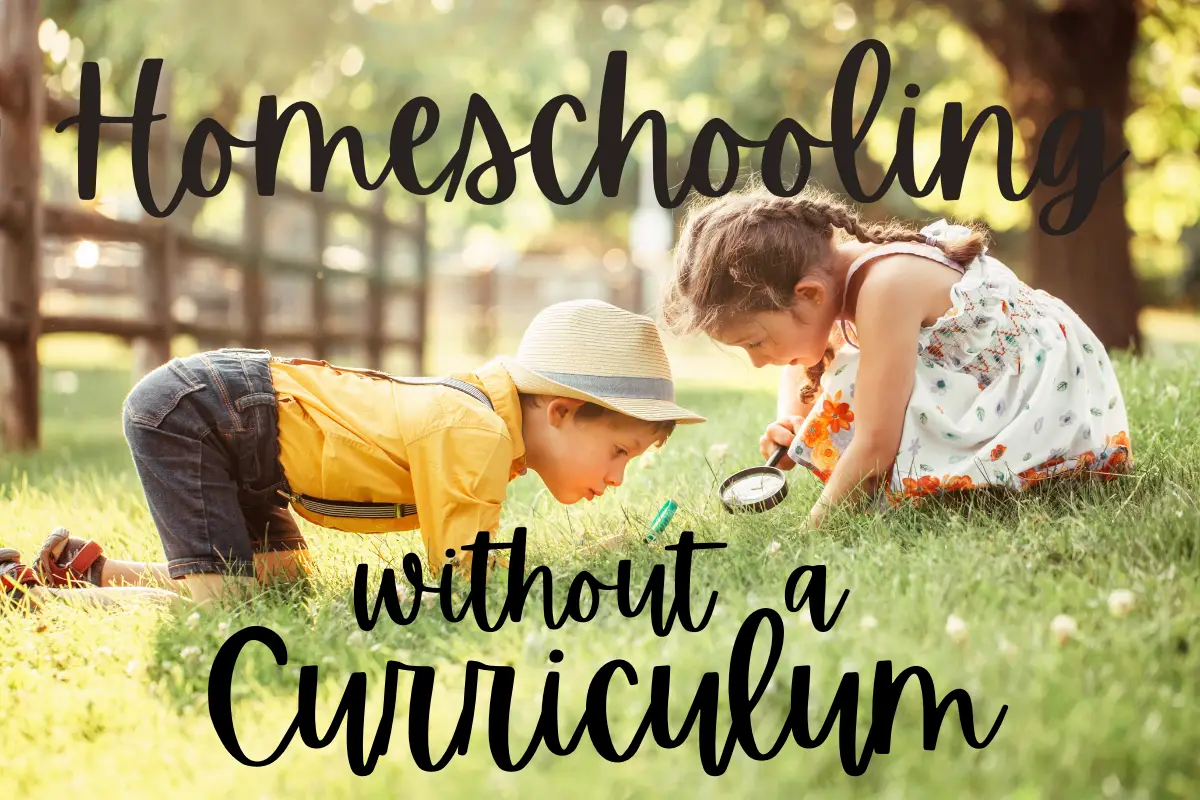Are you considering homeschooling your child, but feeling overwhelmed by all the curriculum choices out there? Don’t worry – you can homeschool without a curriculum!
In this post, we’ll share ideas for how to homeschool without using a curriculum. So don’t let the fear of making the wrong choice keep you from homeschooling – just get started and see what works best for your family!
Adopt the Mentality that Learning is Everywhere

New homeschooling parents are so excited to buy a bunch of textbooks, workbooks, and even full homeschool curricula. I was guilty too!
The best way to homeschool without a curriculum is to change your own mindset that a curriculum is needed in order to successfully homeschool your child. It’s not. But you can’t just say it – you have to believe it.
Be Intentional with Finding Learning Opportunities

Homeschool parents are some of the most resourceful people I know. Those who decide to homeschool without a curriculum need to be intentional and seek out new learning opportunities.
Here are some examples that you can incorporate into your daily lives to create educational moments.
- Cook together.
- Practice life skills such as cleaning, creating a budget, and pumping gas.
- Go on nature walks (don’t forget your nature journal)
- Put on subtitles while watching TV and turn the volume low.
- Go on field trips to places of interest
A few weeks ago, my son and I went on a walk to eat our lunch in a gazebo. Surrounding the gazebo, we found a bunch of pine cones hanging from the trees. This was fascinating to my son, so we spent the next hour collecting pine cones, counting how many we had (over 100), reading about pine cones online, and turning them into an art project. That one lunch ended up being a science, math, and art class!
Learning really is everywhere.
Visit the Library at Least Once a Week

I cannot stress this enough. Go to the library. Let your children pick whichever books interest them. Get to know your librarians and see what free programs they offer.
Some libraries offer free audio books, video rentals, reading programs with prizes, community coloring art projects, and even scavenger hunts!
You can actually fully homeschool your child for free by using the library as your only resource. For real!
Read Aloud to Your Children

Reading aloud to children has so many benefits! Some of the many benefits are:
- Increased vocabulary
- Reading comprehension
- Increased emotional intelligence
- Parent-child bonding
- Learning life lessons
- Deepens focus
- Develops listening skills
Children who develop a love for reading books at an early age are more likely to become independent learners, which in my opinion is the holy grail of homeschooling.
Read Living Books

When we started homeschooling, I had never heard of living books. Living books allow readers to feel transported back in time. They evoke an emotional experience through vivid storytelling.
Which of these writing styles would you rather use to learn about history?
- Textbook – The September attacks (known as 9/11) took place on September 11, 2001, in New York City, New York. Islamic extremists, al-Qaeda, carried out 4 suicide missions and were responsible for killing almost 3,000 people. They flew airplanes into the World Trade Center towers, The Pentagon, and an airplane headed for an unknown destination was successfully overtaken by passengers and crashed into a field, undoubtedly saving hundreds of lives.
- Living Book – I woke up on the morning of September 11, 2001, and started my day as usual. Just before 8:45 am, I noticed there were many planes flying above. I looked out my window to see them and noticed how low they were flying. All of a sudden, the airplane struck the building several floors above where I was sitting. Everyone was screaming and running down the stairs to try to escape. I was able to escape, but I lost many friends that day who died when the building collapsed.
Which writing style are you more likely to remember? Several facts, while important, are less likely to be remembered than picturing the story from the second example.
Play Games Together

Learning doesn’t have to occur from behind a book. Educational games provide a fun way for kids to learn without feeling like they are “doing school.”
Some of our favorite games are:
- Snakes & Ladders (math)
- Uno (colors, math)
- Matching Letter Game (phonics, language arts)
- Guess in 10 – Animal Planet (science)
- Race Across the USA (geography)
You’ll notice the games have incorporated the major subjects. Kids learn a ton through playing and it’s fun for the whole family.
Take an Unschooling Approach

Unschooling is a way of life that incorporates learning into everything. It is a mindset that children have a natural curiosity and love of learning that can be stifled in traditional school settings and rigid curriculums.
If you are considering an unschooling approach, I highly recommend reading these books:
- How Children Learn
- How Children Fail
- The Call of the Wild + Free
- Better Late Than Early
- Unschooled: Raising Curious, Well-Educated Children Outside the Conventional Classroom
Those who use an unschooling method with their children typically create a natural learning environment such as:
- starting a vegetable garden
- leaving books on side tables throughout the house
- tapping into and encouraging their children’s interests
- hanging maps of the world in their playroom
- exploring nature
If you decide to use the unschooling homeschooling method, just remember – it doesn’t matter when your child learns something. It is easy to compare yourself to other homeschoolers, so be mindful of that.
Join Homeschool Co-ops

Don’t feel like you have to do everything when it comes to educating your children. You don’t have to know everything or teach everything – you just have to provide the learning resources.
Try a homeschooling co-op. Homeschooling co-ops are a great way to meet like-minded homeschooling families, make some new friends, and to learn through hands-on activities and crafts.
The picture above is from a homeschooling co-op we attended all about Mardi Gras. We got to listen to the history of Mardi Gras, eat jambalaya, and make masquerade masks. It was a great time and it took the pressure off of me to be the sole educator.
Keep in mind that most homeschooling co-ops are a group effort, so you may need to contribute in some way such as bringing snacks, preparing a lesson, or bringing arts and craft supplies. It’s a great trade off in my opinion!
Create Your Own Unit Studies

Unit studies take 1 topic and incorporate all subjects into learning about the topic. It is a really fun, completely customizable way to learn without using a curriculum.
Let’s take the topic of the Amazon Rainforest.
- Prepare a data chart about the amount of rainfall the rainforest receives yearly by month (science, math)
- Write a report about 3 animals that can be found in the rainforest (writing, grammar, punctuation, language arts)
- Choose 20 words pertaining to the rainforest and learn how to spell them (spelling)
- Watch a documentary about the discovery of the rainforest (history)
The best way to use unit studies to educate your children and get them excited about homeschooling is to let them choose the topic. If the topic interests them, they are much more likely to learn and participate. Here is an extensive list of unit study topics. If you need help building a unit study, read this.
Use Teachers Pay Teachers

Teachers Pay Teachers is a website designed to help teachers share material. You can sort by grade level, subject, topic, and paid versus free.
Find handwriting practice sheets, matching games, math exercises, worksheets, and lesson plans.
Visit National Parks

National parks are so educational! Just by hiking and exploring nature, you can learn so much, and many of them even have programs designed to educate children. These programs are hands-on and make learning a lot of fun.
Some programs offered by national parks are:
- Junior Ranger Program
- Girl Scout Ranger Program
- Youth Conservation Programs
In addition to hands-on activities, they also offer observational activities and guided tours. If you decide to take a national park tour, I highly recommend this Atlas.
Go to Zoos and Aquariums

It’s no secret that kids love animals. Instead of reading about animals from a textbook, go to the zoo or aquarium instead!
Try to incorporate as much learning and fun as possible. Read the signs that tell what the animals eat, how big they are, and what their personalities are like. Answer any questions that your children ask. You can further the educational experience by registering for classes, programs, shows, and special events.
Visit Nature Preserves

Nature preserves are one of my favorite places to visit as a family. It’s quiet and peaceful as well as fun and educational. There are signs to read to tell all about the history of the area and what plants and wildlife to look for. For my son, it feels like a giant scavenger hunt. I read a sign to him and then he looks for the things mentioned. The way his eyes light up when he discovers something we read about makes it one of the most fun things we do together.
Visit Historical Sites and Landmarks

You don’t have to pay to get into a museum to learn about history. Research your area, or better yet, travel to a new area to learn! What famous battles took place there? Were any famous people from history were born there? I remember taking a tour of Thomas Edison’s home with my dad as a child. That image sticks with me much more than it would have if I had read it in a textbook.
Do Science Experiments Together

Hands-on science experiments are so much fun!
Here are some fun science experiment ideas:
- mix colors together to learn what happens when you mix blue and red
- create a snow volcano or apple volcano
- add Mentos into a Diet Coke 2 liter and watch it explode
- mix oil and water
- grow crystals
- create an egg-drop
- make elephant toothpaste
It’s so much easier for kids to retain information that they’ve gained by using multiple senses.
- reading the instructions
- pouring in the ingredients
- smelling the mixture of ingredients
- watching the volcano explode
- hearing the fizzing of the baking soda
No matter which science experiment you choose, kids will enjoy the hands-on activities.
Take Individual Classes

Just because you prefer not to use a full curriculum doesn’t mean your child can’t take individual classes. If your child expresses interest in learning about coding, you could enroll them in an online course. There are programs and classes offered for just about any topic of interest. You just have to facilitate it for them.
Conclusion
So, how do you homeschool without a curriculum? You get creative! There are tons of resources out there to help you teach your children whatever you want. From online classes and textbooks, to unit studies and living books, the options are endless.
The most important thing is that you take the time to find what works best for your family and go with it. Happy Homeschooling!


